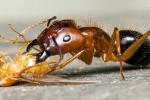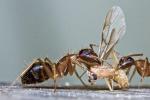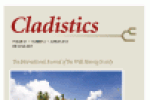Ants reveal surprising colonization history patterns in South Pacific islands
The islands of South Pacific ocean and Southeast Asia are the most biologically diverse regions on Earth. New findings about how ants spread across the islands of South Pacific were published in the last issue of journal Cladistics(http://onlinelibrary.wiley.com/doi/10.1111/cla.2015.31.issue-4/issuetoc).
Under the leadership of Drs. Ronald M.Clouse of UNC Charlotte and Milan Janda of the Czech Academy of Sciences, specimens of the ant genus Camponotus, commonly known as "carpenterants" for their proclivity to makes nests inside of wood, were gathered from a wide variety of expeditions and museum collections. DNA from these specimens and analyzed to ask where this large groups of successful island invaders came from and how they were related to one another. It had long been assumed that they came from Africa, across Asia, and out to the Pacific via the large islands of Indonesia, New Guinea, and the Philippines. Many otherlong-held beliefs about how the species were related and generated new species on remote islands were also tested.
The result was that almost all of the hypotheses about the history of these ants were falsified, and their most likely history was completely unexpected. Carpenter ants in the Pacific are composed of rather unrelated lineages that have invaded these islands via Australia and even the Americas, and within the Pacific they have taken strange colonization routes. The tropical and subtropical areas of northern Australia were the source of a surprising number of colonization events, not the reverse, as had been expected. Moreover, one of the most common species in the entire Pacific turned out to be two rather unrelated species that had evolved to look remarkably similar.
The 15 authors of this paper span several generations of ant researchers who study the Pacific Islands fauna, including one of the most celebrated myrmecologists and biologists, Prof. Emeritus E. O. Wilson of Harvard University. The team analyzed the data under the advisement of another leader in biology, Dr. Ward C. Wheeler of the American Museum of Natural History. Dr. Wheeler developed many of the principles, algorithms, and computing infrastructure used to analyze the DNA sequence data around the world. Prof. Wilson wrote the first comprehensive work on the ants of Polynesia nearly 50 years ago, and for this project contributed specimens he collected on a recent expedition to the Melanesian islands of Vanuatu. Other authors, who range incareer stages and ages all the way to beginning graduate students, contributed specimens from various island groups and landmasses around the Pacific.
The study confirms the power of teamscience and bridging field and computational biology in order to answer fundamental questions about the true diversity and history of life on this planet. For myrmecologists, one of the most popular animals in one of the most complex regions of the Earth is coming into focus, and the true story of ants in the Pacific is far more interesting than had been assumed.


















